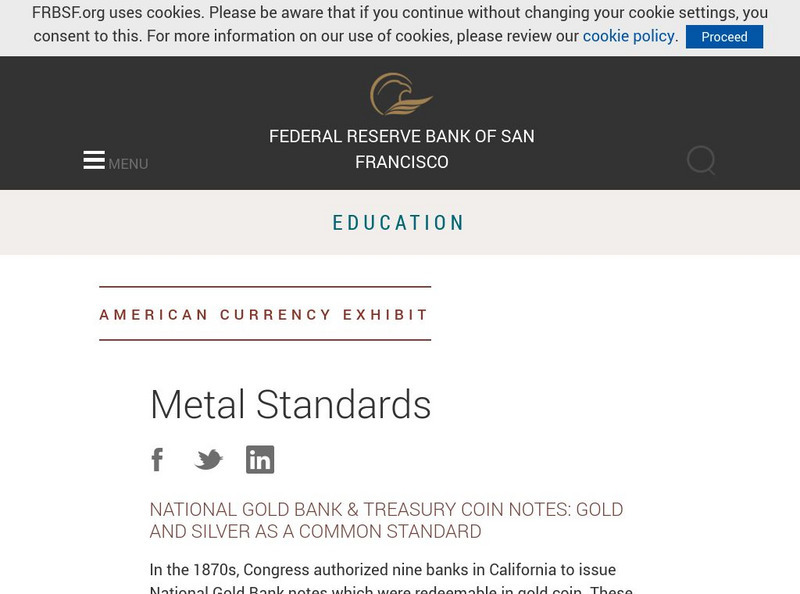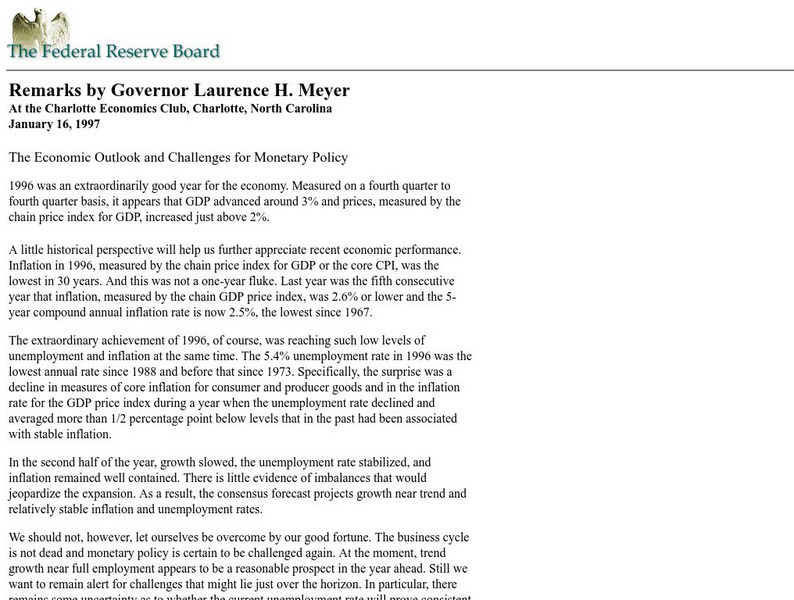Hi, what do you want to do?
Other
Federal Reserve Bank of San Francisco: Chair the Fed: A Monetary Policy Game
The resource consists of a tutorial and learning game about monetary policy. Some topics investigated are reserve requirements, open market operations, discount rate, and tight monetary policy.
Federal Reserve Bank
Federal Reserve Bank of St. Louis: Civilian Unemployment Rate
Provides historical percent, seasonally adjusted, civilian unemployment data for each month from 1948 to the present.
Federal Reserve Bank
Federal Reserve Bank of Atlanta: Spotting Counterfeit Currency
This resource explains how to detect counterfeit money, what to do if you receive it, and the laws against it.
Federal Reserve Bank
Federal Reserve Bank of Philadelphia: What Your Credit Report Says About You
Find out why your credit report is so important to your well-being in today's economy. See where the reports come from, who can see your credit report, what type of information is on it, as well as other important facts about credit scores.
Federal Reserve Bank
Federal Reserve Bank of Atlanta: Building Block Barter Lesson
Lesson plan for 3 - 5 graders about the advantages of using money instead of bartering.
Federal Reserve Bank
Federal Reserve Bank of Atlanta: What Is an Entrepreneur?
Introduces students to the motivations and decision making of entrepreneurs and discusses their economic impact.
Federal Reserve Bank
Federal Reserve Bank of Atlanta: Where Do You Bank?
Introduces students to the factors they should consider when they choose banking services.
Federal Reserve Bank
Federal Reserve Bank of Atlanta: Gross Domestic Product
Highlights the basics about GDP.
Federal Reserve Bank
Federal Reserve Bank of Atlanta: Saving and Investing
Explains the Rule of 72 with examples of compound interest and its power to help grow students' money.
Federal Reserve Bank
Federal Reserve Bank of Atlanta: Economic Systems
Helps students discover the three basic economic questions and how each system answers these questions, identify several key advantages and disadvantages for each economic system, recognize some economic indicators that can measure...
Federal Reserve Bank
Federal Reserve Bank of Atlanta: Price Stability
Highlights the goal of price stability and features price level measures and terminology.
Federal Reserve Bank
Federal Reserve Bank of Atlanta: Maximum Employment
Highlights the goal of maximum employment and features labor market measures and terminology.
Federal Reserve Bank
Federal Reserve Bank of Atlanta: Why Is Good Credit Important?
Introduces students to the relationships among credit history, credit report, and credit score and shows how essential maintaining a good credit history is to financial stability.
Federal Reserve Bank
Federal Reserve Bank San Francisco: American Currency Exhibit: Metal Standards
This site provides information about the expansion of the United States Currency, with links to other related sources.
Federal Reserve Bank
Federal Reserve Bank of Philadelphia: Ten Mile Day [Pdf]
Using the book, Ten Mile Day, by Mary Ann Fraser, this lesson helps children understand division of labor, competition, and incentives in the workplace.
Federal Reserve Bank
Federal Reserve Bank of Atlanta: Budgeting
Illustrates the difference between sources of income and fixed versus variable expenses through a simple budget plan. Introduces students to the basics of budgeting.
Federal Reserve Bank
Federal Reserve Bank of Atlanta: Circular Flow
Explains how resources, goods and services, and payments flow through the economy using the economic model of circular flow.
Federal Reserve Bank
Federal Reserve Bank of Philadelphia: What Is Money? [Pdf]
This lesson plan is designed to help children understand the problems which arise from the bartering system so they appreciate the role money has in society.
The Federal Reserve System
Federal Reserve Board: The Economic Outlook and Challenges for Monetary Policy
A speech given in 1997 which evaluated the economic outlook using the non-accelerating inflation rate of unemployment, or NAIRU, and outlined challenges for monetary policy. (January 16, 1997)
The Federal Reserve System
Federal Reserve Board: Electronic Check Conversion
Article describing the process of electronic check conversion and the rights of the consumer presented in a question-and-answer format.
Other
Federal Reserve Bank of Cleveland: Inflation Central
Students track inflation in the United States and across the world. The resource consists of articles on economic trends, economic commentary, charts, and graphs.
Other
Federal Reserve Bank of Dallas: Economic Drivers of Texas [Ppt]
This PowerPoint presentation explores the different tools that are used by economists to analyze the Texas economy. Through their analysis, you are able to see which industries and business ventures are having the most impact on the...
Federal Reserve Bank
Federal Reserve Bank of St. Louis: What Is Driving Oil Prices?
As the world's demand for oil rapidly increases, so do the prices for it. Learn the factors causing high oil prices and who are the world's largest consumers of petroleum. Includes discussion questions. (Published Jan. 2005)
Federal Reserve Bank
Federal Reserve Bank of Atlanta: Supply & Demand
Highlights basic concepts such as the law of supply and demand, changes in demand and supply versus changes in the quantity demanded and the quantity supplied, the determinants of demand and supply, and market equilibrium.










![Federal Reserve Bank of Philadelphia: What Is Money? [Pdf] Lesson Plan Federal Reserve Bank of Philadelphia: What Is Money? [Pdf] Lesson Plan](http://lessonplanet.com/content/resources/thumbnails/409977/large/bwluav9tywdpy2symdiwmduymc0xmdq5ny16ejvsywouanbn.jpg?1589982800)
